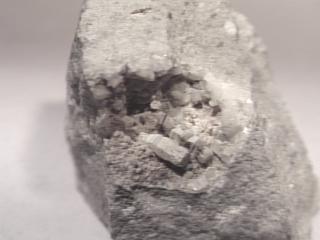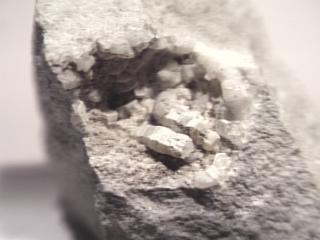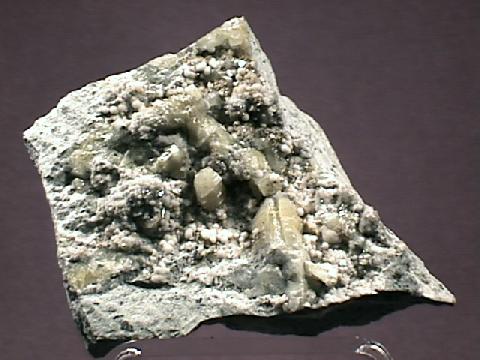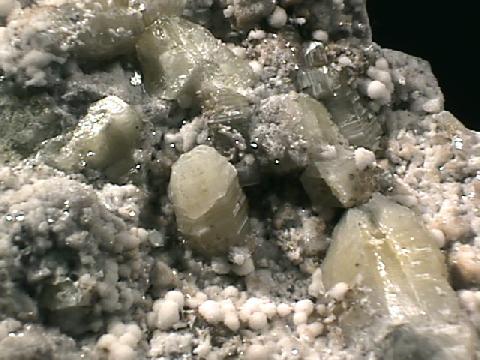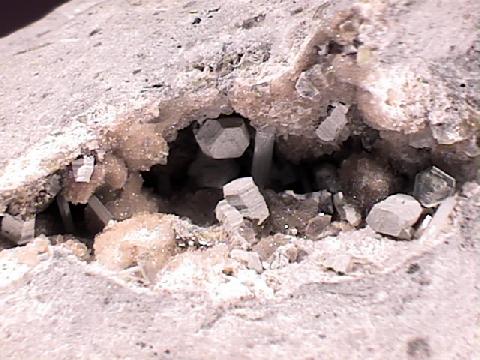 THE MINERAL WELOGANITE
THE MINERAL WELOGANITE
- Chemistry: Na2(Sr, Ca)3Zr(CO3)6 - 3 H2O, Hydrated Sodium Strontium Calcium Zirconium Carbonate.
- Class: Carbonates
- Uses: Only as mineral specimens.
Specimens
The Francon quarry exposes a rare carbonatite sill.
The sill, a horizontal intrusion into parallel host rocks, is composed of carbonate minerals, mostly calcite.
The Francon Quarry has produced a number of rare carbonate minerals besides weloganite such as strontianite and
Like other igneous rocks, the carbonatite starts as a molten body, but is composed of carbonates instead of silicates. Like other igneous rocks, carbonatites will crystallize the minerals that are more stable at higher temperatures and pressures first, leaving difficult elements in the left over melt. Difficult elements are those elements that because of their size and/or charge do not fit well into a mineral's structure and are therefore excluded by most minerals. These elements, like strontium and zirconium, are left to form whatever minerals they can get into as the last bit of crystallization takes place.
In the case of weloganite, the sill had already formed most of its minerals when fluids rich in difficult elements and volatile gases rose to the top of the sill and formed bubbles or pockets. When the excavations at the Francon Quarry uncovered the sill, these "petrified" bubbles were found coated in exotic minerals some of which were never before known to science. It is believed that this unusual sill was somehow allowed to cool much more slowly than other carbonatite sills. It is the time to differentiate the difficult elements that may have made the difference in producing these wonderful minerals. Other carbonatite sills have similar chemistries to the Francon Quarry sill but the difficult elements are incorporated into commoner minerals as trace elements.
Weloganite forms attached crystals that grow into tapered pseudohexagonal prisms. The crystals are occasionally complexly tapered, growing wider and thinner several times before terminating to either a point or a flat pedial face. The color can be a muted amber color and can enhance these already interesting, rare and classic crystals.
PHYSICAL CHARACTERISTICS:
- Color is white, yellowish or amber.
- Luster is vitreous to chalky.
- Transparency crystals are translucent, rarely transparent.
- Crystal System is triclinic; bar 1
- Crystal Habits include pseudohexagonal prisms that often tapper to a point or are terminated by a
pedial face . From their attachment points the crystals will usually taper to a wider width before tapering to their terminations or repeatedly tapering wider and thinner before terminating. - Hardness is 4
- Specific Gravity is 3.2 (slightly above average for transparent minerals)
- Cleavage is distinct in one direction.
- Fracture is conchoidal.
- Streak is white.
- Other Characteristics: heavily striated or repeatedly notched vertically.
- Associated Minerals include strontianite,
dawsonite and calcite. - Notable Occurrences include Francon Quarry, Montreal, Quebec, Canada and only at a few other rare locations.
- Best Field Indicators are locality, crystal habit, striations and color.

